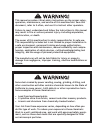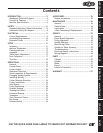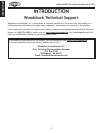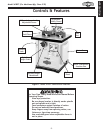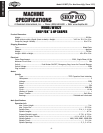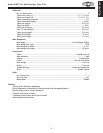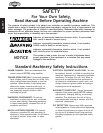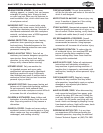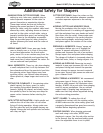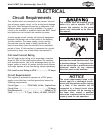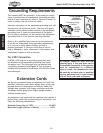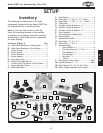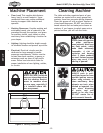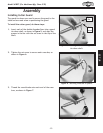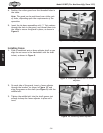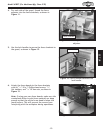
-8-
Df[\cN(/).=fiDXZ_`e\jD]^%J`eZ\*&()
J8=<KP
8[[`k`feXcJX]\kp]fiJ_Xg\ij
>L8I;@E>=IFD:LKK<I<OGFJLI<% When
setting up cuts, take every possible step to
reduce operator exposure to the cutter to
prevent laceration or amputation injuries.
These steps include but are not limited to:
Keeping the unused portion of the cutter
below the table, using the smallest table insert
allowed by cutter, adjusting fences as close as
practical to the cutter on both sides, using a
properly installed box guard, and securing the
guard as close to the workpiece as possible.
B\\gk_\gifm`[\[^lXi[fifk_\igifk\Zk`m\
[\m`Z\jY\kn\\epfli_Xe[jXe[k_\Zlkk\iXk
Xcck`d\j
B<<G@E>?8E;JJ8=<% Never pass your hands
near or directly over or in front of the cutter.
As one hand approaches the 6-inch radius
point, move it in an arc motion away from the
cutter to the outfeed side and reposition that
hand more than 6 inches beyond the cutter. Do
not use awkward hand positions.
JD8CCNFIBG@<:<J% There is a risk when shaping
a small workpiece that it will slip between the
fence boards and draw the operator's hand into
the spinning cutter. Keep fingers away from
revolving cutter—use fixtures when necessary.
Where practical, shape longer stock and cut to
size.
K<JK@E>=FI:C<8I8E:<% If the spinning cutter
should contact the fence, guard, or insert,
the resulting flying debris presents injury
hazards. Unplug the shaper, and always rotate
the spindle by hand to test any new setup for
proper cutter clearance before starting the
shaper.
J8=<:LKK<I@EJK8CC8K@FE% A tight spindle nut
reduces the risk of the cutter or rub collars
flying off during operation. Always make sure
that the arbor key and the spindle keyway are
aligned. Always use both spindle nuts and make
sure they are tight.
:LKK<IGFJ@K@FE@E>% Keep the cutters on the
underside of the workpiece whenever possible
to reduce operator exposure to the moving
cutter.
8MF@;@E>:LKK<I8E;NFIBG@<:<>I89%
Moving the workpiece into the cutter in the
same direction as it is rotating will aggressively
pull the workpiece from your hands and could
draw them into the cutter. Always make sure
the cutter is rotating in the correct direction
before starting shaper, and always feed the
workpiece against the rotation of the cutter.
GI<G8I@E>8NFIBG@<:<% Always "square up"
a workpiece before you run it through the
shaper. A warped workpiece is difficult to
process and increases the risk of an accident.
Always inspect the workpiece before shaping.
The danger of kickback is increased when the
stock has knots, holes, or foreign objects in it.
8MF@;@E>8EFM<ICF8;% Removing too much
material in one pass increases the risk of the
workpiece kicking back toward the operator.
Never attempt to remove too much material
in one pass. Several light passes are safer and
give a cleaner finish.
J8=<CP=<<;@E>8NFIBG@<:<% We recommend
using some type of fixture, jig, or hold-down
device to safely support the workpiece when
feeding. ALWAYS use a push stick when shaping
small or narrow workpieces. Use an outfeed
support table if shaping long workpieces to
make sure that they remain supported during
the entire cutting procedure.
J8=<KP>L8I;J% To reduce the risk of
unintentional contact with the rotating cutter,
ALWAYS make sure the cutter safety guard and
a properly dimensioned box guard are correctly
installed before beginning operation.
:FEKFLIJ?8G@E>% When shaping contoured
work and using a rub collar, NEVER start
shaping at a corner. See the rub collar section
in the manual. Use the overhead safety guard
when the adjustable fence is not in place.



